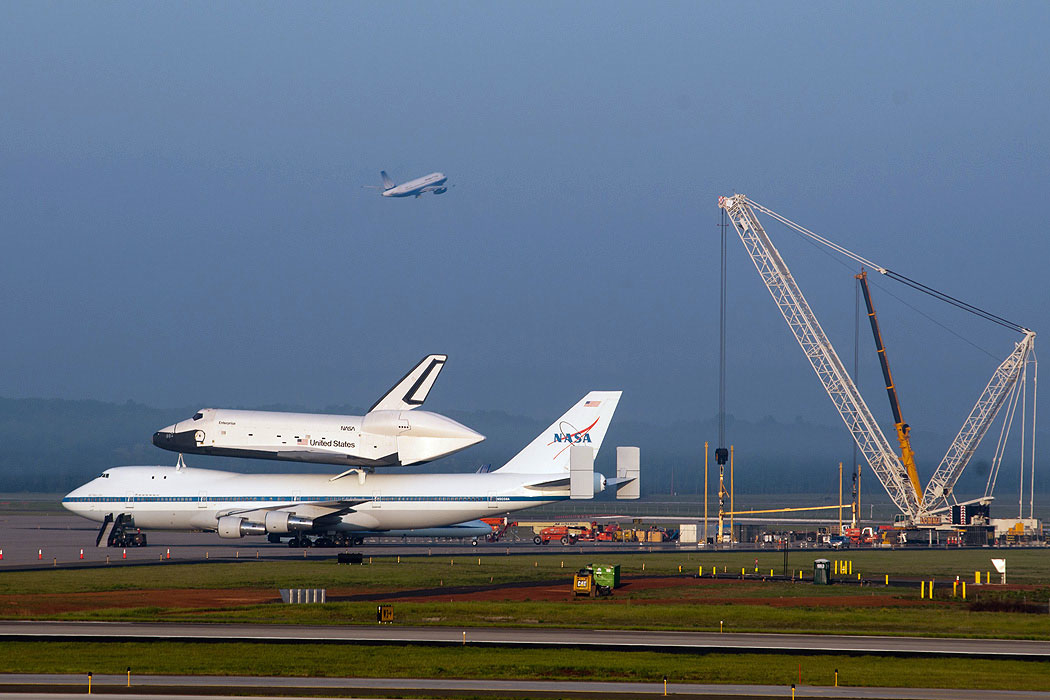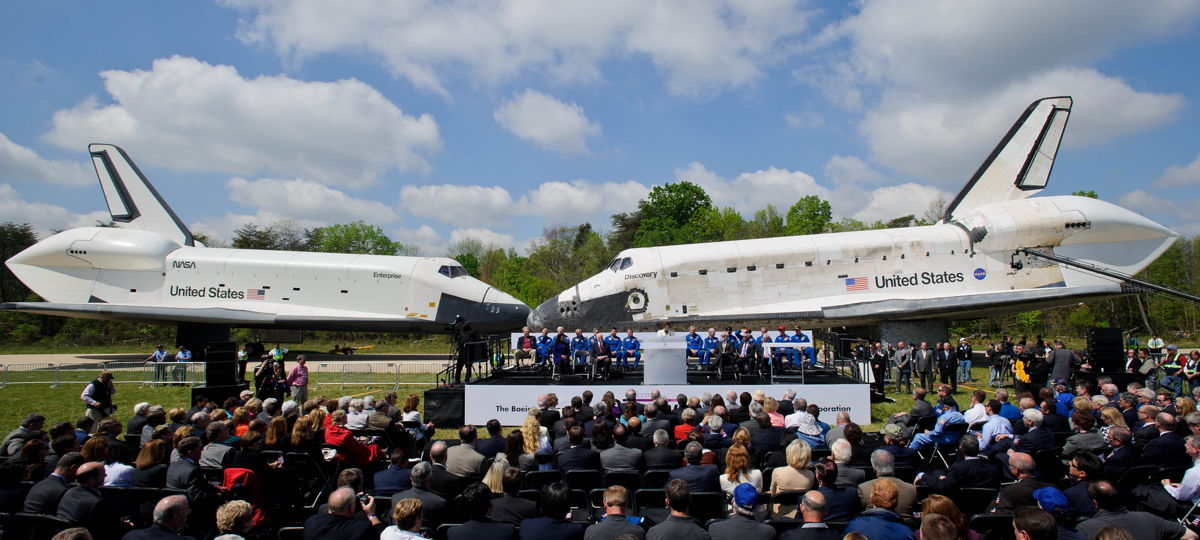NYC-Bound Space Shuttle Prototype Enterprise Reunited with Carrier Aircraft

Update for 4 p.m. EDT, April 20: The Intrepid Sea, Air & Space Museum has announced that Enterprise's flight to New York has been "postponed until further notice due to unfavorable weather forecast" for Monday (April 23). More details to follow when available.
CHANTILLY, Va. -- NASA's original prototype space shuttle was reunited Friday (April 20) with the jumbo jet that first ferried it for a series of important test flights in the late 1970s.
The test orbiter Enterprise was mounted atop NASA's Shuttle Carrier Aircraft, a modified Boeing 747, for its flight next week to New York's John F. Kennedy (JFK) International Airport. Weather permitting, Enterprise is scheduled to depart Washington, D.C., on Monday morning (April 23) to be delivered for display by New York's Intrepid Sea, Air & Space Museum later this summer.
The carrier aircraft, identified by its tail number NASA 905, landed at Washingon's Dulles International Airport carrying another shuttle, Discovery, on April 17. NASA's most-flown spacecraft, Discovery replaced Enterprise at the Smithsonian National Air and Space Museum's Steven F. Udvar-Hazy Center in Chantilly, Va., on Thursday.
To make room to display Discovery, Enterprise — which had been on exhibit at the Udvar-Hazy Center since 2003 — was awarded to the Intrepid in April 2011. [Gallery: Shuttle Discovery Enters Smithsonian]
Together again
Overnight on Thursday, NASA and United Space Alliance (USA) shuttle workers hoisted the prototype Enterprise shuttle atop the Shuttle Carrier Aircraft using two large mobile cranes. The orbiter was outfitted with a metal sling and then lifted high enough so the jumbo jet could pull in underneath. Enterprise was then lowered onto the 747's three protruding attach points.
Get the Space.com Newsletter
Breaking space news, the latest updates on rocket launches, skywatching events and more!
"Soft-mate" was achieved early Friday morning. Workers planned to return Saturday to tighten the bolts connecting the air- and spacecraft for their targeted take off from the airport on Monday between 9:30 a.m. and 11:30 a.m. EDT (1330 and 1530 GMT). Rain showers, as forecasted, could delay the departure, though, until later next week.
Enterprise was last mated with the Shuttle Carrier Aircraft more than a quarter-century ago, on Nov. 18, 1985, when the shuttle arrived at Dulles from NASA's Kennedy Space Center in Florida for its donation to the Smithsonian. The two craft have a much longer history, though, dating back to the first flights of the space shuttle program.
Before its sister space-worthy orbiters could fly and return from space, Enterprise flew a series of piloted approach and landing test (ALT) flights in 1977 to verify the shuttle's handling as an unpowered glider, gauging how the winged vehicles would land after re-entering the atmosphere. Two pairs of two astronauts each flew Enterprise to a landing at Edwards Air Force Base in California after the orbiter was lofted to altitude by NASA 905.
In the three decades since, Enterprise went on to perform a series of ground tests, including acting as a fit check for launch pads in Florida and California. NASA 905 and Enterprise were then paired again for an overseas promotional tour, including a stop at the Paris Air Show in 1983.
The prototype orbiter then became a museum exhibit while the Shuttle Carrier Aircraft continued to fly the space-flown shuttles on ferry flights between landing and launch sites, as well as maintenance facilities.
After dropping off Enterprise in New York, NASA 905 will have just one more shuttle flight remaining — delivering Endeavour to California in September — before also being retired. (NASA's other remaining shuttle, Atlantis, does not need to fly anywhere; it currently sits at Kennedy Space Center and will go on display at that facility's visitor complex.)

Carrier landing
For the Enterprise, its future includes being mounted on a different type of carrier. A converted World War II aircraft carrier, the Intrepid Sea, Air & Space Museum has plans to exhibit the shuttle on its flight deck.
After touching down at JFK, Enterprise and NASA 905 will spend a few weeks attached together as NASA re-stages the cranes used to load the shuttle in Washington at the New York airport. Enterprise will then be kept in a hangar, awaiting its barge to the museum.
In June, Enterprise will be craned onto the flight deck and the Intrepid's new "Space Shuttle Pavilion," a temporary climate-controlled steel-and-fabric structure, will be built around it. The exhibit is expected to open to the public in mid-July.
To make room for Enterprise, three historic aircraft were hoisted off of Intrepid's deck on Wednesday.
A Supermarine Scimitar F.1 British Royal Navy fighter bomber, a Douglas F3D-2 (F-10) Skyknight and a Mikoyan Gurevich MIG-15 aircraft were each lifted by crane and placed onto the pier, then lifted again and placed onto a barge for transportation to their new home at the Empire State Aerosciences Museum in upstate New York.
Before landing on the flight deck, and prior to touching down at JFK, Enterprise and NASA 905 will perform a flyover of New York City, with low passes expected near the Statue of Liberty and the Intrepid.
Meanwhile, waiting at the airport, a crowd of 1,500 invited guests, including state and local politicians, will be on hand to watch Enterprise arrive.
Visit shuttles.collectspace.com for continuing coverage of the delivery and display of NASA's retired space shuttles.
Follow collectSPACE on Facebook and Twitter @collectSPACE and editor Robert Pearlman @robertpearlman. Copyright 2012 collectSPACE.com. All rights reserved.
Join our Space Forums to keep talking space on the latest missions, night sky and more! And if you have a news tip, correction or comment, let us know at: community@space.com.

Robert Pearlman is a space historian, journalist and the founder and editor of collectSPACE.com, a daily news publication and community devoted to space history with a particular focus on how and where space exploration intersects with pop culture. Pearlman is also a contributing writer for Space.com and co-author of "Space Stations: The Art, Science, and Reality of Working in Space” published by Smithsonian Books in 2018.In 2009, he was inducted into the U.S. Space Camp Hall of Fame in Huntsville, Alabama. In 2021, he was honored by the American Astronautical Society with the Ordway Award for Sustained Excellence in Spaceflight History. In 2023, the National Space Club Florida Committee recognized Pearlman with the Kolcum News and Communications Award for excellence in telling the space story along the Space Coast and throughout the world.










